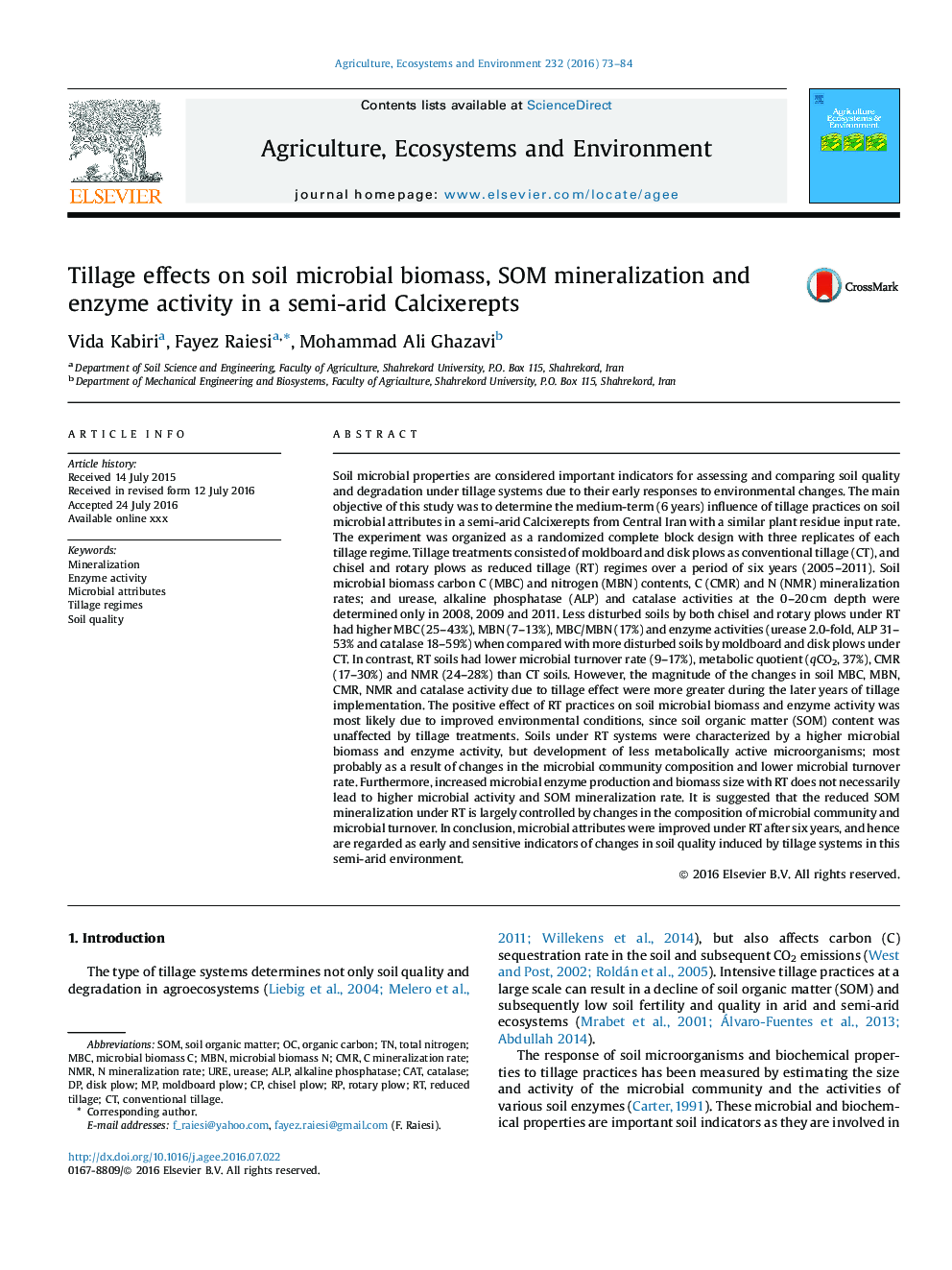| کد مقاله | کد نشریه | سال انتشار | مقاله انگلیسی | نسخه تمام متن |
|---|---|---|---|---|
| 8487306 | 1552020 | 2016 | 12 صفحه PDF | دانلود رایگان |
عنوان انگلیسی مقاله ISI
Tillage effects on soil microbial biomass, SOM mineralization and enzyme activity in a semi-arid Calcixerepts
دانلود مقاله + سفارش ترجمه
دانلود مقاله ISI انگلیسی
رایگان برای ایرانیان
کلمات کلیدی
MBCCMRCATUREMBNSOM - WHOALP - آلکالن فسفاتازAlkaline phosphatase - آلکالین فسفاتاز یا فسفاتاز قلیاییUrease - اوره آزMicrobial biomass C - بیوماس میکروبی CMicrobial biomass N - بیومس میکروبی NNMR - تشدید مغناطیسی هستهای Chisel plow - شخم زدنConventional tillage - شخم زدن معمولیEnzyme activity - فعالیت آنزیمSoil organic matter - ماده آلی خاکMineralization - معدنی سازی یا کانی سازیtotal nitrogen - نیتروژن کاملMoldboard plow - چمن زنیCatalase - کاتالازreduced tillage - کاهش خراشOrganic carbon - کربن آلیSoil quality - کیفیت خاک
موضوعات مرتبط
علوم زیستی و بیوفناوری
علوم کشاورزی و بیولوژیک
علوم زراعت و اصلاح نباتات
پیش نمایش صفحه اول مقاله

چکیده انگلیسی
Soil microbial properties are considered important indicators for assessing and comparing soil quality and degradation under tillage systems due to their early responses to environmental changes. The main objective of this study was to determine the medium-term (6 years) influence of tillage practices on soil microbial attributes in a semi-arid Calcixerepts from Central Iran with a similar plant residue input rate. The experiment was organized as a randomized complete block design with three replicates of each tillage regime. Tillage treatments consisted of moldboard and disk plows as conventional tillage (CT), and chisel and rotary plows as reduced tillage (RT) regimes over a period of six years (2005-2011). Soil microbial biomass carbon C (MBC) and nitrogen (MBN) contents, C (CMR) and N (NMR) mineralization rates; and urease, alkaline phosphatase (ALP) and catalase activities at the 0-20Â cm depth were determined only in 2008, 2009 and 2011. Less disturbed soils by both chisel and rotary plows under RT had higher MBC (25-43%), MBN (7-13%), MBC/MBN (17%) and enzyme activities (urease 2.0-fold, ALP 31-53% and catalase 18-59%) when compared with more disturbed soils by moldboard and disk plows under CT. In contrast, RT soils had lower microbial turnover rate (9-17%), metabolic quotient (qCO2, 37%), CMR (17-30%) and NMR (24-28%) than CT soils. However, the magnitude of the changes in soil MBC, MBN, CMR, NMR and catalase activity due to tillage effect were more greater during the later years of tillage implementation. The positive effect of RT practices on soil microbial biomass and enzyme activity was most likely due to improved environmental conditions, since soil organic matter (SOM) content was unaffected by tillage treatments. Soils under RT systems were characterized by a higher microbial biomass and enzyme activity, but development of less metabolically active microorganisms; most probably as a result of changes in the microbial community composition and lower microbial turnover rate. Furthermore, increased microbial enzyme production and biomass size with RT does not necessarily lead to higher microbial activity and SOM mineralization rate. It is suggested that the reduced SOM mineralization under RT is largely controlled by changes in the composition of microbial community and microbial turnover. In conclusion, microbial attributes were improved under RT after six years, and hence are regarded as early and sensitive indicators of changes in soil quality induced by tillage systems in this semi-arid environment.
ناشر
Database: Elsevier - ScienceDirect (ساینس دایرکت)
Journal: Agriculture, Ecosystems & Environment - Volume 232, 16 September 2016, Pages 73-84
Journal: Agriculture, Ecosystems & Environment - Volume 232, 16 September 2016, Pages 73-84
نویسندگان
Vida Kabiri, Fayez Raiesi, Mohammad Ali Ghazavi,